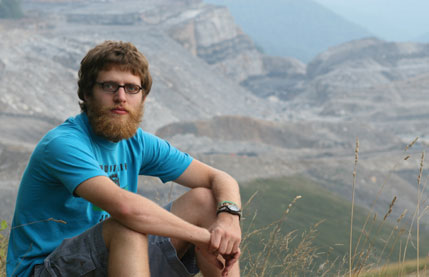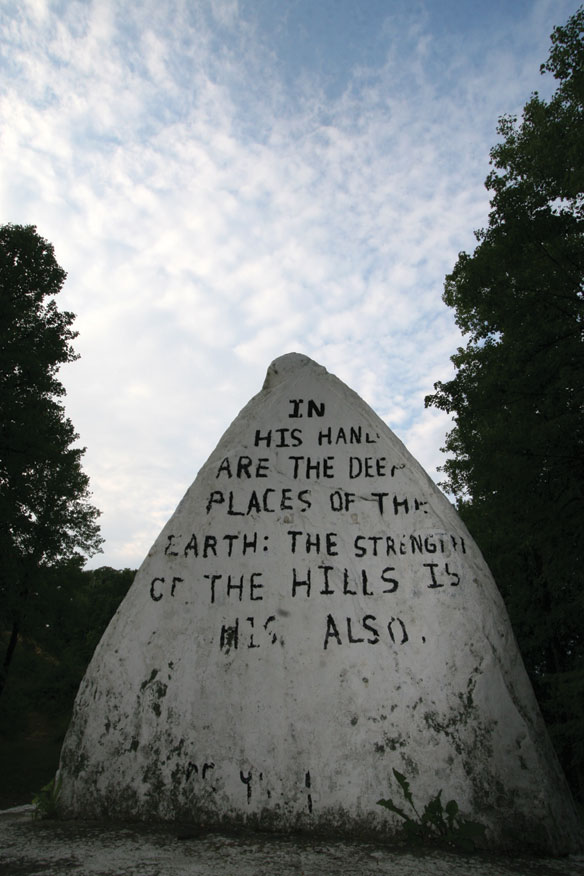Works in Progress: Mountain Justiceby Nathan Rutz '09 |
| Printer-friendly version | Email this article |
|
Funded by a Dill Internship Grant, Nathan Rutz spent two months in West Virginia with Mountain Justice Summer, a non-profit "call to action from the people of the Appalachian mountains for help in saving mountains, streams, and forest" from controversial "mountaintop removal" coal mining. His experiences—whether he was hanging out with the people of Coal River, WV, working with activists in the Justice movement, or dropping in on a revival at The Jesus Church—challenged his beliefs about government and made him more determined to defend the environment and the people and local culture it sustains. WM asked him for a glimpse of his experience.
My first time up was with Matt Noerpel, a slender, red-headed 25-year-old environmental engineer from New Jersey who participated in the first Mountain Justice Summer in 2005 and never left West Virginia. We were driving up to change the rechargeable batteries in the security cameras Matt installed for Larry Gibson, the only remaining permanent resident on Kayford Mountain, the man they call "The Keeper of the Mountains."
To get to Kayford Mountain Road, you have to drive up Clear Fork to a big, circular orange sign for a gas station that’s not there anymore. The town of Clear Fork used to be a much bigger, but there are fewer jobs nearby these days.
We make a left, drive past a few rows of houses, and start climbing at about a 35-degree angle. Then the pavement ends. This is the first gravel mountain road I have ever been up. I can’t quite see what the drop offs look like from the passenger-side window, but, switchback after switchback, I feel the hillside getting steeper as we climb. When my sense of wonder overcomes my dread of falling, occasional glimpses I get of the ridges beyond the trees become increasingly magnificent, framed by tiny blooming wildflowers. We roll by piles of lustrous black and blue butterflies, alongside an exposed rock wall being carved by a perpetual drip along the road.
Between looks at the scenery, Matt and I laugh about snack foods we loved as little kids. I mention Funyons, how unnatural and weird they seem now, but how delicious and cool they were in third grade. Matt mentions snacking on Slim Jims, a thing of the past now that he’s a strict vegan.
"Dude, do you remember Munchos?"
I ask. "Those things are freakin’ crazy."
"Munchos?!" Matt grins. "Hell yeah!"
Reaching Larry’s cabin, Matt and I change the rechargeable batteries in the hunting cameras that are Larry’s security cameras, installed after his cabin was burned down and one of his dogs was shot. Larry is certain someone supporting the coal industry did it.
As we walk up a wooded path, Matt shows me what wood sorrel looks like, tells me that it’s good to eat. We see two mine breaks, where abandoned underground mines have collapsed, causing a split all the way to the surface. The mine breaks here are caused by artificial seismic activity—mountaintop blasting by Massey Energy, the state’s largest coal producer, run by CEO Don Blankenship, the man The New York Times said might as well be governor for all the power he wields.
The end of the trail is my introduction to the process of mountaintop removal (MTR)—how it starts, and where all the bits of exploded mountain go. To our left is an area being mined—a blasted gray canyon with machines scattered throughout. In front of us is a "reclaimed" area. The reclaimed area is a field of dying sod streaked with erosion. The miners are barely visible. Matt tells me that the tires on their trucks are 16 feet tall.
Our conversation grows grim as we drive back down Kayford Mountain Road.
"If you were hiking and saw Don Blankenship hanging off the edge of a cliff, what would you do?" I ask Matt.
"I think I’d help him up," he says. Pauses. "No, I’d definitely help him up. What about you?"
"To be honest, I think I’d walk on by."
I’m beginning to understand why Matt is so committed to this work, and why he never left West Virginia. And, in the ensuing weeks at the Coal River Mountain Watch Campaign House, I discover there are many other reasons someone might want not to leave West Virginia and the anti-MTR movement. I learn to sword fight with Jen, activist and part-time wolf trainer. I talk about music with dread-locked and bearded Bobby, listen to Hillary’s stories of her days doing high profile direct actions with Greenpeace. I laugh when 15-year-old Coal River resident Dustin talks about showing off for "hot women," and I sit on the porch getting made fun of by Charles Ballard.
Charles Ballard is 71, bald, brags on his Suzuki Sidekick like it’s a Lamborghini, has no teeth, and claims to have smoked since he was six. Depending on how it fits the night’s conversation, he may also have a woman in every county, or he might tell you that one is as much as any man could ever need. Charles is from Dry Creek, just a few miles up the road, and has lived there most of his life.
Charles rolls up to the campaign house in a jeep slathered with "I love Mountains" bumper stickers, yelling about the valley’s latest news. Next thing I know, his old belly button’s winking at me from the under his plaid shirt that’s only buttoned twice.
"Betcha did’n know I came round here earlier today didja? Heh heh."
I brace myself for some revelation;
"Hey Bobby, d’you know what this guy was doin’ earlier?"
"Nope," Bobby replies.
"He was locked in the closet cryin’ since his girlfriend left."
"Y’know Charles, we’ve got some mighty fine vegetables all cooked up right now," I retaliate.
"You an your goddam vegtables," Charles says. "How can you eat nothin’ but vegtables?"
He crinkles his face and lights another cigarette to get the imagined taste of vegetables out of his mouth.
One of my favorite stories is about a day Charles says he really stuck it to Massey. Charles was going fishing and took a road owned by a Massey subsidiary. He drove straight toward the guard shack in protest. The guard caught a glimpse of the stickers on Charles’ Jeep and said, "I don’t like your stickers!" Charles yelled back, "Well that’s good, ’cause I don’t like goddamn Massey!"
"Sir, you can’t come up this road."
"Is that so?" Charles told the guard as he reached toward the floor of his Jeep.
"Go on! Go on!" the guard stammered, waving him through.
"That’s what I thought," Charles chuckled as he drove off.
"This is my home, and them mountains are pretty," Charles tells me. I can’t think of better justification for ending mountain top removal.
On my second trip up Kayford Mountain, I finally got to meet Larry Gibson. My girlfriend had come to visit, and I thought she needed to see the destruction. It was just good luck that we met Larry—he was actually waiting for some photographers when we arrived.
I’d read about Larry; his story has been told in magazines and newspapers from Audubon to Oprah. He’s something of a hero in the anti-MTR movement—he’s been fighting for more than 20 years.
They arrive in a rental van, sporting the trappings of city-dwelling artists. Still, Larry treats them the same as anyone else. He jokes with my tall girlfriend, "For every step you take, I have to take three." He’s more than 60 years old, but Larry walks the trail quickly.
He stops for a moment when we reach what he calls "the Gates of Hell." It’s the edge of Larry’s family land trust. The ground past the gate is coal company property.
There’s a sign on a tree there that says before any blasting, a series of warning whistles will blow. Larry tells us they hardly ever actually follow that protocol, and he ducks under the gate.
We stand on the edge of a cliff overlooking thousands of acres of bare rock and machinery. The roar of engines echoes from hundreds of feet below. Larry’s jovial voice turns solemn, almost weary. He mentions matter-of-factly that he’s been shot at. He tells us about the protests where he’s been arrested, of the reporters from other countries that have come to learn about MTR, and how the people of West Virginia suffer from having "the best politicians money can buy." I wish the photographers would hurry up and stop worrying about the lighting and take their shots. Standing here so close to the mining feels like watching an assault from a few feet away.
Larry takes us to the Stanley family cemetery. It’s much larger than I’d imagined, the graveyard for quite an extended family. There are fresh flowers at several of the headstones. Larry quietly shows us where to step and how to avoid treading on the ground immediately in front of a headstone. I look at the markers as we pass. Some are fairly recent, others are much older. Still other markers have disappeared, or gone smooth.
In a few places, the ground in front of the headstone sinks. Larry tells us that’s where the graves have collapsed because of the nearby blasting. Then he points out an even older cemetery to us. He says that the cemetery has graves over 270 years old, but most of them are totally sunken in. The graveyard is an island surrounded by strip mining. It’s illegal to strip mine a cemetery, but the coal company has the mineral rights and has mined under it. Underground mining mixed with blasting is just the thing to collapse graves, Larry tells us.
Coming back from the cemetery, I notice something I’d missed on my last trip. I’d seen the white rock that used to mark the road to the church on Kayford Mountain—John 3:16 is painted on the front of it. But on the back in fading black paint, Psalm 95:4 reads, "In His hands are the deep places of the earth, the strength of the hills is His also." I’d never heard that verse before.
I stayed at the campaign house five days after my family left, spending much of my time four-wheeling, swimming with Dustin (who was still on the lookout for "hot women"), and making fudge for the Coal River Watch campaign house crew (and Charles Ballard, of course). As I packed up to go home, I wasn’t nearly as excited about finally getting to read the seventh and final Harry Potter book as I had imagined I would be when I planned my return date months ago.
The farmer-poet Wendell Berry writes, "To countenance mountaintop removal in West Virginia is to agree to the destruction of Yosemite or Yellowstone."
I could see Kayford Mountain in my mind even as I drove home to Cincinnati, even as I drove past the five coal-fired power plants that line the road along the Ohio River, even as they filled my mind with images of the land and the people of West Virginia ad come to love.
Read about Mountain Justice Summer at www.mountainjusticesummer.org
|

 The drive up Kayford Mountain Road is an awakening.
The drive up Kayford Mountain Road is an awakening. "STOP MOUNTAINTOP REMOVAL" in black on the most violently fluorescent yellow I have ever seen emblazons Larry’s hat and the t-shirt stretched over his belly. "The Keeper of the Mountains" is about as tall as my shoulder. He seems glad we’re there and offers to show us around with the photographers.
"STOP MOUNTAINTOP REMOVAL" in black on the most violently fluorescent yellow I have ever seen emblazons Larry’s hat and the t-shirt stretched over his belly. "The Keeper of the Mountains" is about as tall as my shoulder. He seems glad we’re there and offers to show us around with the photographers.